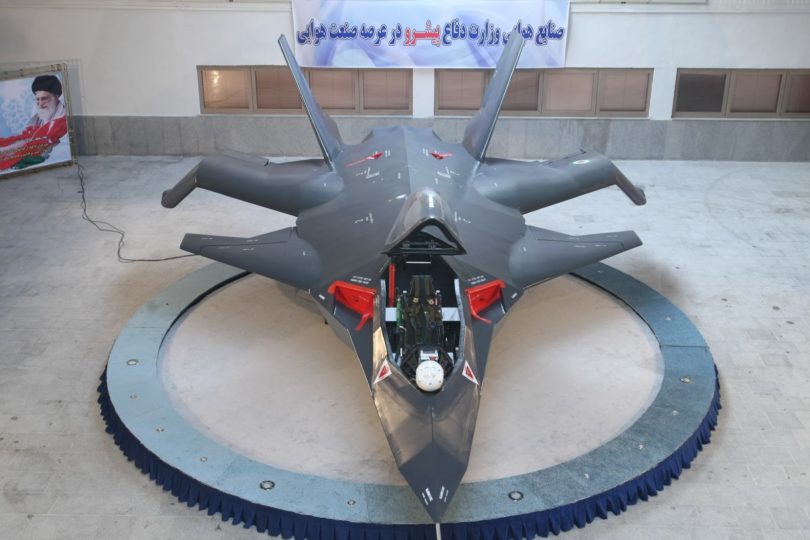Seven years ago, Iran rolled out its ‘fifth-generation’ Qaher-313 ‘stealth fighter jet’ in presence of then-President Mahmoud Ahmadinejad, supposedly the country’s most advanced warplane
The jet initially greeted with skepticism, became a laughing stock among the military enthusiasts, who dismissed it as a crude mock-up and a stunt designed to impress the domestic audience.
The military aviation experts after taking a cursory look at the images and videos released by Iran showing the fighter jet said it was simply impossible for this ‘prototype’ to even fly.
The single-engine aircraft was far too small to perform and had too many engineering flaws to even qualify as a fourth-generation jet. Qaher-313 looked more like a Hollywood prop than it did a 21st-century jet fighter, experts concluded.
The jet features hard edges and those distinctive edges and angle of the US F-22 and the twin tail shape much similar to that of the F-35 Lightning II, The Aviationist concluded. The Q-313 has large, fixed canards, with the external section of the little wings canted downward.
The aircraft spots a bizarre cockpit, armed with instruments that aren’t of the ‘fifth-gen’ era and too basic, the front panel lacks any wirings, with instruments similar to those equipping small private plane.

Qaher-313 is built with a nose section that is so small that almost no radar could fit in it. Now the most important part – the air intakes, which are so small that it reminds you of drones with similar intake sizes. Heck, the jet has no nozzle at all! The engine afterburners would melt the entire jet.
Billed as the country’s most advanced indigenous fighter jet, Qaher-313 is so small that there literally isn’t enough space under its wings for the bombs and missiles that the country claimed it could carry; it doesn’t even have a weapons bay. The cockpit is so small that it can’t accommodate a normal pilot in the ejection seat.
The aviation experts say it’s not normal to have a fighter jet where the pilot’s knees rise above the side borders of the cockpit and his helmet protrudes beyond the ejection seat’s head pad.
Iran tried to reinforce confidence in the world community by releasing a video showing the fighter jet flying, which was busted as being an absurd photoshop within hours.
The country’s attempts to bamboozle its rivals with such a crude piece of fraud failed badly, and experts wondered how Iran could present such a farce and not be exposed.
Despite being universally mocked as a falsification, Iran continued to assert that its newest fighter jet was real and already flying. The country’s government insisted the aircraft was even ‘superior’ to Lockheed Martin F-22 Raptor and the F-35 Joint Strike Fighter and would be operational soon. So, where’s the aircraft now?
The project has apparently disappeared with no further talk heard about its viability or future operational plans, as expected.
In August 2018, Iran unveiled the Kowsar fighter jet, with the country claiming that the new jet had “advanced avionics” and multi-purpose radar, and it was “100-percent indigenously made” for the first time.
The state media broadcast live footage of the new fighter taxiing along a runway at a defense show, but it was soon cut before the plane took off.
In a televised interview after unveiling the new jet, Iran’s defense minister Amir Hatami said, “We have learned in the (Iran-Iraq) war that we cannot rely on anyone but ourselves. Our resources are limited and we are committed to establishing security at a minimum cost.”
The US state department refuted Iran’s claim of its newest Kowsar fighter jet being of ‘domestic origin’, saying, “It seems that regime officials are not sufficiently familiar with the development of the aviation industry.
Their plane is very similar to a fighter jet produced by the United States decades ago and Iran has an old fleet of these planes. Deception is their favorite means.”
Israel also expressed doubts about Iran producing its own fighter jet, saying they were inventing ‘anecdotes’ and that they were under pressure because of the American sanctions. The experts claimed the jet was really a ‘1970s US design with a fresh coat of paint.’
They termed Kowsar as being a knockoff of the F-5 Tiger, a US jet that first flew in 1959.
#Iran 'Kowsar' indigenous fighter – prototype 3-7400 (2018)#US Northrop F-5F Tiger II combat capable trainer – prototype 00889 (1974) pic.twitter.com/b8vJ7qGd9n
— Joseph Dempsey (@JosephHDempsey) August 21, 2018
This year in July, Iran announced that after the ‘success’ in manufacturing the Kowsar warplane, the country’s air force has started the process of manufacturing a homegrown heavy fighter jet.
Iran’s Air Force is currently armed with 20 Russian MiG-29s and 23 Sukhoi Su-24 jets, about 17 Chinese-built Chengdu F-7s (a license-built copy of the Soviet MiG-21), close to 50 US-made F-4 Phantom IIs, 20 Northrop F-5s, two dozen Grumman F-14s and 9 Mirage F1s, which are now heavily modified and customized after decades of US arms restrictions.
The years of arms embargo imposed by the US and its allies on Iran has deprived the country of key technology and equipment to enable it to modernize its military. While the country made quick progress in missile development, developing a fifth-generation fighter jet that could challenge the air superiority of its rivals still remains a dream.
Follow EurAsian Times on Google News




